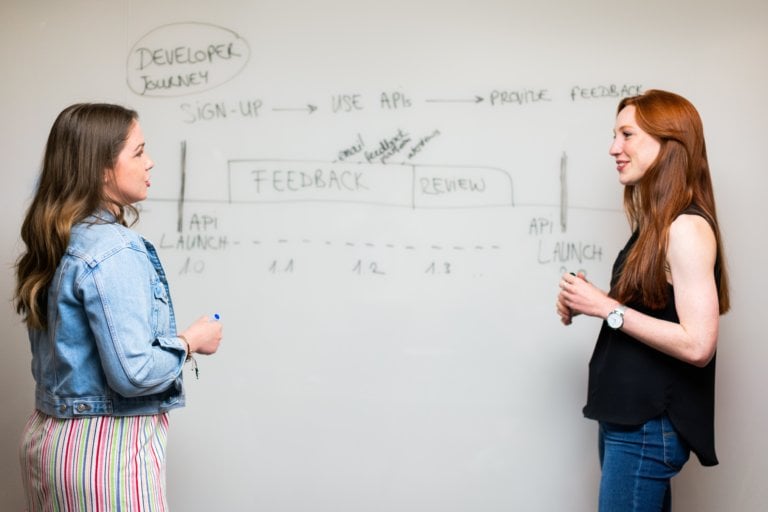Want a simple way to boost morale, strengthen culture, and inspire better performance? It starts with giving great feedback.
Positive feedback is one of the most powerful, low-cost tools any manager has. When employees feel seen and appreciated, they’re more engaged, more motivated, and more likely to stick around.
In this guide, you’ll learn why positive feedback matters, how to give it so it truly lands, and see real examples you can use today to lift your team and your company culture.
Key Takeaways
- Recognizing employees for their hard work boosts morale, strengthens team dynamics, and helps create a healthy company culture.
- Effective feedback is specific, delivered directly, and given in the moment.
- Regular positive feedback builds trust and makes it easier to have tough conversations when you need to.
- Employees who feel like they are appreciated are more likely to stay longer, work harder, and care about the success of the business.
Why Is Positive Feedback Important?
Positive feedback can strengthen company culture, improve employee engagement, and ultimately impact your long-term business’s stability.
If you’re wondering why giving positive feedback to your team is so important, here are a few reasons:
- It shows them they’re on the right track. Recognizing an employee whose work improves results, supports their team, and reflects company values encourages them to keep up their great work.
- It promotes effort, not just results. Specific, sincere praise goes a long way for employees who are consistent with can-do attitudes. Acknowledging that effort can motivate employees to continue performing and, in some cases, even go above and beyond.
- It improves team dynamics. Positive feedback can help build better working relationships. When recognition becomes routine, it drives collaboration and eases pressure in the workplace.
- It shapes company culture. A company that celebrates and encourages wins (big or small) becomes a place where employees feel supported and motivated.
- It makes constructive feedback easier. When employees know what they’re doing right, they’re more willing to hear about how they can improve and grow. Positive feedback paves the way for productive conversations.
- It builds confidence. People perform better when they believe in themselves. Positive feedback increases your employees’ confidence by emphasizing their value at work.
The Watercooler EP 08: Positive Feedback Examples to Improve Company Culture
Jessica and Tod discuss real-life examples of positive feedback in the workplace. Learn how to give constructive praise that motivates and encourages team members effectively.
How to Give Positive Feedback
Positive feedback works best when it’s clear, personal, and connected to the bigger picture. Here’s how to make sure your praise truly resonates with employees and drives the right behaviors.
Be Specific and Concrete
Avoid vague praise like “Good job.” Point to the exact action or behavior, why it mattered, and how it impacted the team, project, or company goals.
Example: “Your quick response to the client’s request helped us close the deal a week early.”
Focus on Behaviors and Effort, Not Just Results
Recognize the process as well as the outcome. Praising persistence, creativity, or collaboration reinforces those behaviors and motivates employees even when results take time.
Make It Timely
Deliver feedback as close to the action as possible so the employee can connect your recognition to their behavior. Timely praise feels more genuine and has a greater impact.
Choose the Right Setting
Some feedback is best given privately, while other praise can be amplified in a team meeting or company announcement. Match the setting to the person and the achievement.
Use a Sincere, Personal Tone
Keep your delivery authentic. Avoid scripted or generic language, and speak in a way that matches your genuine appreciation.
Link Praise to Company Values
Whenever possible, connect your feedback to core values or business priorities. This helps employees see how their work contributes to the bigger picture.
Takeaway: Make your feedback specific, timely, and tied to company values so it motivates employees and reinforces the behaviors you want to see.
Pro Tip
Document feedback in your employee recognition tool so it’s easy to revisit during reviews and goal-setting.
When to Give Positive Feedback
When you give positive feedback matters just as much as what you say. Praising someone at just the right moment can make a big difference.
Be prompt
Timing can make or break the impact of your feedback. Well-timed recognition reinforces the behavior you want to see more of and keeps morale high. Here’s how to get the timing right.
Immediately After the Behavior
Recognize employees as soon as possible after the achievement or positive behavior. This strengthens the link between the action and your praise, making it more likely to be repeated.
Example: Congratulating a team member right after they resolve a tricky client issue shows you’re paying attention and value their quick thinking.
During Key Milestones
Celebrate anniversaries, promotions, and major project completions. These moments provide natural opportunities to recognize long-term contributions and commitment.
In the Middle of a Challenge
Acknowledging effort during high-pressure periods—like tight deadlines or busy seasons—can keep morale from dipping and motivate the team to push through.
When Employees Demonstrate Core Values
If someone models your company’s values—whether it’s teamwork, innovation, or customer service—call it out right away. This reinforces those values for the whole team.
In Regular Check-Ins and Meetings
Don’t save feedback for annual reviews. Incorporate it into one-on-ones, weekly standups, or team meetings so recognition becomes part of your workplace routine.
Takeaway: Offer recognition at the moment it matters most—whether right after an achievement, during a challenge, or when someone exemplifies core values—to maximize its impact.
Pro Tip
If the moment passes before you can give feedback in person, send a quick message or voice note that same day. It keeps your recognition relevant and meaningful.
13 Examples of Positive Feedback
Now that we’ve covered how and when to give meaningful feedback, let’s dive into specific examples of positive feedback in the workplace.
Positive Feedback for Client Relations
Example:
“Our client said you were a pleasure to work with and kept them updated throughout the project. Thank you for always treating our clients with respect and kindness. You give our company a good name!”
Why it’s meaningful:
Maintaining healthy professional relationships reflects well on not only your leadership skills but also the company. Here, you’ve shown that building client relations is a priority for the company, and the team’s efforts to be friendly won’t go unnoticed.
Pro Tip
With Connecteam, you can easily create feedback surveys and live polls. Let your team share their insights and feel heard!
Recognizing Outstanding Project Work
Example:
“Your work on the Green Project was invaluable, and the team couldn’t have done it without you. Thank you for your hard work and dedication!”
Why it’s meaningful:
It recognizes the employee’s contribution and highlights how their efforts benefitted the team.
Encouraging Growth in a New Role
Example:
“Since becoming a team leader, your confidence has grown, and your team’s results really show it. Well done for embracing the challenge!”
Why it’s meaningful:
It demonstrates appreciation for growth, flexibility, and leadership. You’re making sure that the employee’s effort hasn’t gone unnoticed.
Highlighting Collaboration Success
Example:
“You played a key role in the project’s success. Thank you for guiding team conversations and helping each member feel included and valuable.”
Why it’s meaningful:
It emphasizes collaboration and communication as core company values and encourages your employees’ leadership and initiative.
Pro Tip

Encourage your team to share feedback after completing a project or reaching the end of a quarter. You can use Connecteam to easily create feedback surveys and live polls. Not only will this help you receive meaningful feedback, but employees themselves will be able to review peer feedback examples. Help them recognize the difference between a simple compliment and meaningful, effective feedback.
Marking Work Anniversaries and Milestones
Example:
“Congratulations on five years of working with us! Your positivity and leadership have energized and inspired the whole team. We are excited for many more years together!”
Why it’s meaningful:
It recognizes loyalty and consistency, both of which are essential to long-term growth.
Pro Tip
Keep track of every milestone, promotion, and shoutout in one place. With Connecteam’s employee timeline, watch your team grow with your business.
Spotlighting Personal Development
Example:
“You’ve become more confident in your client interactions. It’s been great to see your growth over the past three years.”
Why it’s meaningful:
It acknowledges effort and self-improvement over time, which encourages continued development.
Uplifting Morale During Tough Times
Example:
“I know this month has been hard for you, but you’ve shown up and tried your best. I’m grateful for your dedication.”
Why it’s meaningful:
It shows empathy and appreciation for your employee’s effort, which is important to maintaining morale.
Acknowledging Leadership Skills
Example:
“You guided the team through the last several projects smoothly. It’s been great to see your leadership skills develop.”

Why it’s meaningful:
It highlights the employee’s impact as a leader and sets an example others should follow.
Recognizing Initiative and Going the Extra Mile
Example:
“You jumped in to help on the last project without being asked. That initiative really made a big difference.”
Why it’s meaningful:
It shows that going above and beyond doesn’t go unnoticed and is valued.
Celebrating Process Improvements
Example:
“Your solution to the product ordering backlog saved us time and stress. Great job thinking outside the box to simplify the process!”
Why it’s meaningful:
It recognizes innovation and creativity as valuable skills in the workplace.
Praising Commitment to Self-Improvement
Example:
“I can see you’re working hard to improve your organizational skills. Your commitment means a lot and I am excited to see your growth.”
Why it’s meaningful:
It acknowledges intention and effort, not just the final outcome.
Appreciating Peer Support Efforts
Example
“You’ve been a huge support for the new employees. Your encouragement and patience is really making a difference in their onboarding.”
Why it’s meaningful:
It praises an employee for helping others, showing the value of teamwork and collaboration.
Commending Conflict Resolution Skills
Example:
“Thank you for helping your team find a scheduling compromise that kept everyone happy! Staying calm under pressure is a really impressive quality.”
Why it’s meaningful:
It shows that emotional intelligence is a valued asset and promotes peer-to-peer conflict resolution.
Reward Hard Work & Effort with Connecteam
Connecteam’s free Recognition and Rewards feature provides the perfect platform for encouragement and feedback. With a wide selection of pre-made recognitions to choose from, plus the ability to make your own, you can customize recognitions to suit your company’s needs.
Easily recognize your star players
With Connecteam, you have multiple ways to celebrate employee achievements, milestones, and congratulate them on their successes. Easily put your employees in the spotlight with customizable badges or recognize them publicly when completing a task or project.
You can do this by tagging a team member in the company newsfeed along with a high-five or star emoji to convey your appreciation.

Reward employees for a job well done
The Rewards feature helps build a positive company culture and highlights your employees’ success. Connecteam collaborates with leading vendors and retailers, so you can gift employees digital tokens that they can redeem for gift cards.
To mark important milestones and achievements, Connecteam automatically flags key events, like work anniversaries, on the employee timeline. In addition, managers can keep track of employee accomplishments by manually adding them to their timelines.
The Bottom Line
Positive feedback is one of the simplest and most effective ways to build a thriving workplace.
When recognition is specific, timely, and genuine, it not only boosts morale but also drives better performance, stronger relationships, and long-term loyalty.
Make it part of your leadership routine—not an afterthought—and you’ll create a culture where people feel valued, motivated, and ready to give their best every day.
FAQs
Positive feedback is when a manager or colleague recognizes and reinforces an employee’s actions, behaviors, or results that align with company goals. It clearly identifies what was done well so the employee can repeat it, boosting confidence, engagement, and workplace culture.
Positive feedback is important because it reinforces desired behaviors, strengthens trust between team members, and makes employees feel valued. Over time, this improves motivation, loyalty, and talent retention while supporting a healthy workplace culture.
Positive feedback highlights what is working well, while constructive feedback addresses areas that need improvement. Positive feedback motivates and maintains good behaviors, and constructive feedback guides development and problem-solving.
In positive feedback, name the specific action, explain its value, and connect it to broader goals. For example: “Your quick follow-up with the client kept the project on track and showed great attention to detail.” Avoid vague phrases like “Good job.”
“You handled the client’s complaint with patience and professionalism, which turned a potential cancellation into a renewal.” This is specific, timely, and tied directly to a positive business outcome.
Write positive feedback by identifying the exact behavior, stating its impact, and showing appreciation. Example: “Your clear instructions helped me finish my section early, giving the team extra review time. I appreciate your guidance.”
Short positive feedback phrases include: “Great teamwork under pressure,” “Your attention to detail impressed the client,” and “Thanks for stepping in when it mattered most.” Each should be specific to the situation.
Positive feedback should be given regularly, not just during annual reviews. Weekly check-ins, meetings, and casual conversations are ideal opportunities to keep morale high and reinforce desired behaviors.
Yes. Too much positive feedback, especially if vague or repetitive, can feel insincere. Feedback should be specific, relevant, and proportional to the achievement to remain credible.
Give positive feedback remotely using video calls, chat tools, or recognition software. Mention the specific action, explain why it mattered, and, when appropriate, share it publicly to maximize impact.





